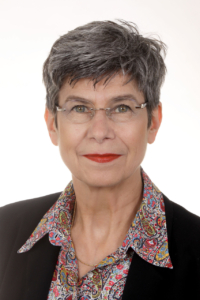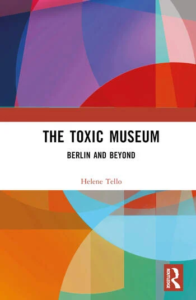INTRODUCING VISITING FULBRIGHT SCHOLAR HELENE TELLO
 Helene Tello will be in residence at the UCLA/Getty Conservation Program from May through October, 2024. She will be researching the Native American Grave Protection and Repatriation Act (NAGPRA) as part of her Fulbright scholarship. Her research takes place against the background of debates on neocolonialism that have risen in Germany and Europe and the demands of indigenous people to museums for collaboration and restitution of their cultural assets.
Helene Tello will be in residence at the UCLA/Getty Conservation Program from May through October, 2024. She will be researching the Native American Grave Protection and Repatriation Act (NAGPRA) as part of her Fulbright scholarship. Her research takes place against the background of debates on neocolonialism that have risen in Germany and Europe and the demands of indigenous people to museums for collaboration and restitution of their cultural assets.
Helene is currently a freelance senior conservator. Starting her career in 1980, she opened her own conservation studio in 1983. She then moved on to the Vonderau Museum in Fulda, Germany. Subsequently, she looked after the Native American collections at the Ethnologisches Museum of the Staatliche Museen zu Berlin (Ethnological Museum of the National Museums in Berlin), Germany, from 1998 to mid-2020. There, she encountered the topic of pesticides formerly used on objects. She conducts research on decontamination methods of such treated cultural assets as well as safe handling of them for everyone who must deal with it. Due to the opening of museum collections to indigenous people, who started collaborating with the museums as well as repatriating their own cultural assets, her many years of expertise are extremely important in our time. Her knowledge is spread out through numerous journal contributions, teaching activities and lectures at home and abroad.
As Helene describes her current research, “I see myself as a qualified ambassador to find solutions for the challenges associated with contaminated non-European cultural assets in the US and to implement them in a future project in Germany.” The use of pesticides at non-European objects in museums was most thoroughly studied in Germany. Such poisoned objects cause significant damage to the health of indigenous people while coming into physical contact with their objects during cultural ceremonies. In North American museums, the Native American Grave Protection and Repatriation Act (NAGPRA) has strongly fostered intensive collaboration between First Nations communities and museums. At UCLA/Getty, Helene is working with Prof Ellen Pearlstein, and connecting with colleagues across California and the US. Today, there is an urgent need for German museums to develop standards during restitution processes of cultural assets from indigenous people.
Helene’s current studies are based on her book The Toxic Museum – Berlin and Beyond, published on February 28, 2024 at Routledge (Francis & Taylor Group) https://www.routledge.com/The-Toxic-Museum-Berlin-and-Beyond/Tello/p/book/9781032526348.
The inspiration for this research of the use of pesticides in museum collections during the heydays of ethnological museums came through her work as a conservator in the Ethnologisches Museum (EM) in Berlin from the late 1990s onwards. Coming from the world of wood conservation, she looked after about 70,000 objects in the study collection of American Ethnology until June 2020. The collection items were stowed away in many cabinets, some of them completely overcrowded. These objects made of organic materials are exposed to constant danger against plant and animal pests, as well as mold. When the cabinets were opened, an unknown smell unfolded in the supervised collection, which on the one hand seemed pungent, biting; and on the other, musty-sweet. Next to the objects, on the shelves of the cabinets, small containers were filled with synthetic camphor to protect against harmful insects. At this time, the chemist Dr. Achim Unger from the Rathgen-Forschungslabor (RF) of the Staatliche Museum in Berlin, drew her attention to the former use of pesticides in the collections. Initial investigations of material samples of individual objects soon led to the conclusion that these artefacts are contaminated with toxic substances such as synthetic camphor, heavy metals and/or organochlorine compounds. Handling ethnological objects contaminated by formerly applied pesticides inevitably led her to the question of where the employees of the EM and the RF had obtained their active ingredients and means for the prevention and control of harmful insects during the heydays of the museum. However, the legacy of these applications from the late 19th and early 20th centuries is increasingly coming to the fore in public interest through current debates in museums, often followed by the restitution of non-European cultural assets to their countries of origin.


